This site is supported by our readers. We may earn a commission, at no cost to you, if you purchase through links.
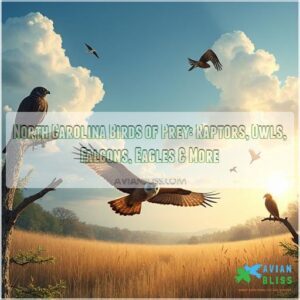 North Carolina birds of prey are masters of the skies, from the lightning-fast Peregrine Falcon, reaching 240 mph, to the graceful, fork-tailed Swallow-tailed Kite.
North Carolina birds of prey are masters of the skies, from the lightning-fast Peregrine Falcon, reaching 240 mph, to the graceful, fork-tailed Swallow-tailed Kite.
Falcons, like the American Kestrel, hover over fields hunting rodents, while Northern Harriers glide low with an owl-like facial disc to spot prey.
You’ll also find Ospreys near lakes, diving for fish, and Bald Eagles nesting in tall trees.
Each raptor plays a pivotal role in maintaining balance, but their survival depends on conservation efforts.
Spotting these predators in action is pure magic—next time, watch their unique flight styles to level up your birding game.
Table Of Contents
- Key Takeaways
- Falcons, Kites, and Harriers in North Carolina
- Rare Species and Conservation
- Osprey and Bald Eagle in North Carolina
- Red-Tailed Hawk Identification and Habitat
- Red-Tailed Hawk Nesting, Reproduction, and Conservation
- Other Birds of Prey in North Carolina
- Birds of Prey and Human Interactions
- Finding and Caring for Injured Birds of Prey
- Frequently Asked Questions (FAQs)
- What is the largest bird of prey in North Carolina?
- What are the most common hawks in North Carolina?
- What bird is mistaken for a hawk?
- What is the most common bird in North Carolina?
- Where can you See Birds of prey in North Carolina?
- What is the smallest bird of prey in North Carolina?
- Are horned owls common in North Carolina?
- How many birds are in North Carolina?
- Are bald eagles extinct in North Carolina?
- What is a Accipitridae bird?
- Conclusion
Key Takeaways
- You’ll find a variety of birds of prey in North Carolina, from lightning-fast falcons like the Peregrine Falcon to majestic Bald Eagles nesting near waterways.
- Raptors like Ospreys, Northern Harriers, and Swallow-tailed Kites play vital roles in ecosystems, offering incredible birdwatching experiences.
- Conservation efforts, such as habitat preservation and nesting site protection, are crucial for these birds’ survival and thriving population numbers.
- Observing hunting styles, nesting habits, and unique flight patterns enhances your birding skills and appreciation of these predators.
Falcons, Kites, and Harriers in North Carolina
You’ll find falcons, kites, and harriers soaring across North Carolina’s skies, each with unique hunting styles and habitats.
From the lightning-fast Peregrine Falcon to the Swallow-tailed Kite, these birds showcase incredible aerial skills that make them unforgettable to watch.
Falcons Found in The Carolinas
If you’ve ever admired the falcons of North Carolina, you’ll know they’re masters of speed and cunning.
These incredible birds thrive throughout the Carolinas, showcasing unique behaviors and habitats.
- American Kestrels, the smallest falcons, hover-hunt over open fields for insects and small prey.
- Peregrine Falcons, famed for reaching speeds over 240 mph, claim nesting spots on rugged cliff ledges.
- Merlins, swift forest hunters, exhibit precision to catch small birds mid-flight.
- Falcon Conservation is essential, especially as Peregrine Falcons remain a threatened species in the region.
Kites in The Carolinas
Floating effortlessly through the skies, the kites of North Carolina are a must-see for any NC bird watching enthusiast.
Two fascinating kite species you’ll spot in the Carolinas habitat are the sleek Mississippi Kite, with its smooth gray feathers and square tail, and the stunning Swallow-tailed Kite, known for its striking black-and-white contrast and elegant forked tail.
Their kite behavior is mesmerizing, marked by graceful, buoyant flight as they scout for prey like insects and small reptiles.
Often seen near rivers, forests, or coastal wetlands, these kites put on a show during kite migration, particularly in the warmer months.
Thanks to ongoing bird conservation, these mesmerizing north carolina birds of prey are thriving.
Harriers in The Carolinas
Northern Harriers are a standout among North Carolina raptors, effortlessly gliding over open landscapes in the winter, with their low flight and owl-like faces giving them a unique edge.
You’ll often spot these birds of prey in the Carolinas’ wetlands, marshes, and fields, where their low flight and owl-like faces give them a unique edge.
Unlike most hawks of North Carolina, Harriers rely on both sight and sound to pinpoint prey like voles and small mammals.
- Thrive in marshes, prairies, and wide-open fields
- Use their distinct facial disc to detect sounds
- Males are faster, staying lower than females while hunting
- Diet includes rodents, small birds, and insects
- Frequently seen in Wildlife Refuges during Harrier Migration
Harriers’ graceful movements and fascinating behaviors make them a highlight of the NC bird watching experience.
Identifying Falcons, Kites, and Harriers
North Carolina birds of prey offer incredible variety, and spotting the differences between falcons, kites, and harriers isn’t as tricky as it sounds.
Let’s break it down with some tips to sharpen your NC falcon identification skills. For more specialized resources, explore these NC falcon identification products.
- Falcons: Known for speed, they’re sleek with sharp, pointed wings and narrow tails. During falcons migration, look for the Peregrine Falcon or the tiny, colorful American Kestrel darting through the skies.
- Kites: These masters of gliding often sport graceful forked tails. Their bird plumage is elegant, with light, clean tones. Watch for them soaring near rivers or open fields.
- Harriers: Often found hugging marshes or grasslands, their hunting style is distinct—flying low with a slow, methodical glide. The owl-like facial disk helps them locate prey in harrier habitat.
For feather identification tips, visit the NC Raptor Center and see these raptors close up!
Rare Species and Conservation
You might spot some rare birds of prey in North Carolina, like the Gyrfalcon or Crested Caracara, though sightings are uncommon.
Protecting their habitats and supporting conservation efforts are essential to guarantee these exceptional species thrive.

Documenting Rare Bird Sightings
Spotting rare species feels like hitting the birding jackpot.
Join the NC Bird Atlas project!
With your smartphone or camera, snap photos for detailed bird tracking.
Share these moments through sighting reports on eBird or within north carolina birding groups.
Every image or note contributes to citizen science.
Even beginners help reveal clues to birds of prey nc like hidden raptors.
Gyrfalcon and Eurasian Kestrel in North Carolina
If you’re lucky, you might spot a Gyrfalcon or Eurasian Kestrel in North Carolina, rare gems among birds of prey NC.
These visitors, migrating beyond their usual ranges, turn birding into an adventure.
Here’s how to document these rarities:
- Capture photos highlighting their prey behavior.
- Note exact location and habitat details.
- Contact the NC Raptor Center.
- Share findings with Bird Conservation groups or falcon migration databases.
Crested Caracara in The Carolinas
Among North Carolina birds of prey, the Crested Caracara stands out as a rare and unforgettable sight.
Found in open fields and grasslands, this bold raptor boasts a vibrant orange face and feathered crown.
Unlike other nc predator birds, Caracaras often walk on the ground, showcasing unique prey capture strategies.
Though rare, Carolinas sightings often feel extraordinary.
Known for adaptability in their habitat, these raptors symbolize nature’s surprises, offering incredible opportunities for raptor identification nc enthusiasts.
Conservation Efforts for Birds of Prey
Thanks to ongoing conservation efforts, North Carolina’s birds of prey are thriving.
Places like the Carolina Raptor Center play a huge role in raptor conservation, having rehabilitated over 10,000 birds while championing habitat preservation.
Partnerships with climbing groups have helped safeguard Peregrine Falcon nesting sites, a great example of communities rallying for avian conservation. For more information, explore this North Carolina falcons resource.
Organizations like the NC Wildlife Federation focus on species preservation by restoring forests and wetlands, reducing pollutants, and creating wildlife protection programs.
They run educational outreach and build living museums to inspire responsible birdwatching and respect for bird of prey conservation.
By minimizing human impact, these incredible conservation efforts guarantee future generations can admire North Carolina’s majestic skies filled with raptors.
Osprey and Bald Eagle in North Carolina
You’ll spot Ospreys and Bald Eagles near North Carolina’s lakes, rivers, and coastal areas.
These powerful raptors hunt and nest in these locations.
Known for their sharp talons and keen eyesight, they are symbols of nature’s strength and beauty.
Osprey Habitat and Behavior
Ever watched an Osprey in action? These expert anglers live in North Carolina’s shallow waters, always near an endless fish supply.
Their nesting locations might surprise you—anything from dead trees and man-made platforms to chimneys or urban scaffolding becomes home. They’re thriving in places like Lake Norman and Lake Wylie, and their adaptability is unmatched.
Here’s what makes their fishing behavior a spectacle:
- They hover mid-air, pinpointing fish with astonishing precision.
- Then, they plunge feet-first into the water, grasping prey with hooked talons.
- Exceptionally designed for flight, their outer toes even rotate for a better grip.
During migration patterns, many fly thousands of miles, returning here year after year.
Identifying Bald Eagles in The Wild
Spotting a Bald Eagle in North Carolina is all about field marks. Look for their white head and tail popping against a dark brown body and their massive seven-foot wingspan.
Juveniles? They’re fully brown, lacking the iconic plumage. Bright yellow beaks and broad wings complete the picture.
From nesting locations near water to sharp eagle vocalizations, these majestic raptors are unforgettable. Bird identification doesn’t get more iconic than this!
Bald Eagle Nesting and Feeding Habits
Bald Eagles in North Carolina are masters of design, choosing nesting locations near water for easy access to food. Their nesting habits involve teamwork, with both parents building colossal nests—sometimes weighing over a ton! These nests, perched high in trees, can last for decades with yearly repairs.
Bald Eagles thrive as opportunistic hunters. Fish dominates their eagle diet, but they’re not picky. Prey preferences range from turtles to small mammals.
Once the eggs hatch, chick rearing ramps up:
- Both parents share hunting duties.
- Prey is torn into bite-sized pieces.
- Meals feed hungry eaglets.
- Nests serve as feeding stations.
- Survival hinges on parental care.
Conservation Status of Osprey and Bald Eagles
The Bald Eagle and Osprey have shown amazing population trends in North Carolina, thanks to bird conservation efforts like habitat restoration and legal protections. You’ll often glimpse them near Jordan Lake or Lake Norman. The Catawba River, a 225-mile stretch, now supports thriving osprey populations, as detailed in this North Carolina osprey conservation overview.
- Nesting platforms boost osprey recovery by minimizing habitat threats.
- Regular monitoring programs track eagle and osprey conservation progress.
- Preserved waters provide essential fishing grounds.
With ongoing recovery efforts, these birds thrive, but protecting habitats and adapting to future challenges like climate change remains key.
Red-Tailed Hawk Identification and Habitat
You can spot a Red-Tailed Hawk by its broad wings, reddish-brown tail, and piercing cry that echoes through open fields.
These adaptable raptors thrive in North Carolina’s forests, grasslands, and along roadside perches, watching for their next meal.
Red-Tailed Hawk Appearance and Size
The Red-Tailed Hawk, a striking raptor in North Carolina’s skies, boasts rich plumage variations. Adults display dark brown backs, pale undersides, and streaked bellies, with tail feather patterns of distinct rusty-red.
Juvenile markings differ, featuring barred tails instead of the rusty-red adult tails.
Their size dimorphism is notable: females are larger, reaching up to 25.6 inches long, while males are slightly smaller. With a wingspan comparison of 44.9-52.4 inches, they glide effortlessly. Their curved beaks and sharp talons make them perfect hunters.
| Hawk Trait | Description | Fun Fact |
|---|---|---|
| Plumage Variations | Brown backs, pale streaked bellies | Juveniles lack red tail feathers. |
| Tail Feather Patterns | Adults showcase rusty red tails | Barred patterns define juveniles. |
| Wingspan Comparison | Stretches 44.9-52.4 inches | Females often outsize males. |
| Size Dimorphism | Females: 25.6 inches, larger | Males: Slightly smaller |
| Juvenile Markings | Barred tails, mottled bodies | Look for duller tails when spotting. |
Red-Tailed Hawk Habitat and Distribution
The Red-Tailed Hawk’s NC distribution spans mountains, plains, and suburbs, showcasing impressive urban adaptation. Their range expansion reflects resilience despite habitat threats.
These hawks thrive in various preferred habitats:
- Ridges and hills, soaring on thermals for hours.
- Farmlands, where rodents and open fields offer easy hunting.
- Suburban areas, perched on streetlights, unbothered by people.
- Coastal plains, using scattered trees to survey prey below.
Hunting Habits of Red-Tailed Hawks
Red-tailed hawks waste no energy—perching on poles or branches to spot prey such as mice, squirrels, and rabbits.
Their hunting techniques rely on razor-sharp eyesight and swift, calculated dives. Aerial hunting shows their adaptability as they pursue birds in flight.
With powerful talons and exceptional speed, these hawks are NC’s masters of precision, embodying their role as predator with unmatched finesse and strategic hawk behavior.
Diet and Prey of Red-Tailed Hawks
A red-tailed hawk’s diet often reflects its prey availability, showcasing its remarkable dietary adaptations. These raptors rely on squirrels, mice, and rabbits as primary food sources but won’t pass up snakes or smaller birds. Their sharp talons and keen eyesight make hunting techniques incredibly effective. You might catch one perched, scanning for motion below before swooping down with unmatched precision.
- Primary food sources: rodents, rabbits, and birds
- Hunting techniques: perched ambush or soaring patrols
- Dietary adaptations: seasonal preferences, opportunistic feeding
- Prey availability: influenced by local habitat
Red-Tailed Hawk Nesting, Reproduction, and Conservation
You’ll find that red-tailed hawks are careful nest builders, often using high trees or cliffs to protect their young.
Understanding their reproductive habits and the conservation efforts surrounding them helps guarantee these majestic birds thrive in North Carolina’s ecosystems.
Red-Tailed Hawk Nesting Habits
High above North Carolina’s forests, Red-Tailed Hawks create impressive nesting havens, mastering the art of bird engineering.
These raptors favor nest locations 20–90 feet up in sturdy hardwoods for safety and excellent views.
They construct their nests using the following methods:
- Using sticks and twigs, they craft durable nests.
- They add bark strips and evergreens to soften the structure.
- Each spring, they return for nest building and expand their homes before starting the incubation period and chick rearing.
The combination of these efforts results in a well-structured home for the Red-Tailed Hawks.
Reproduction and Mating Habits of Red-Tailed Hawks
Every spring, Red Tailed Hawks put on breathtaking courtship displays across North Carolina’s open skies. These birds mate for life, kicking off their breeding season with aerial acrobatics that showcase their elegance and bond.
You’ll see them performing intricate mating rituals, soaring up to 1,000 feet before diving in graceful arcs. The male wins his partner’s trust through bold flight feats, while the pair synchronizes their movements.
- Male hawks dive dramatically, showcasing strength and agility.
- Pairs soar in tight circles, reinforcing their lifelong partnership.
- Bonding often includes vocalizations and displays of trust.
This trust facilitates smooth nest building, egg incubation, and later, chick rearing during the vulnerable fledgling survival phase.
Conservation Status of Red-Tailed Hawks
Protected by legal measures and thriving across North Carolina, the red-tailed hawk exemplifies successful bird conservation. Decades of habitat preservation and strong population stability show the species’ resilience.
Despite current threats like habitat loss, these hawks are remarkably adaptive, nesting in forests and urban spaces alike.
| Aspect | Current Status |
|---|---|
| Population Stability | Increasing steadily |
| Legal Protections | State and federal laws |
| Future Outlook | Promising across NC |
North Carolina’s efforts support a brighter future for this incredible bird of prey!
Interactions With Humans and Pets
When red-tailed hawks hunt near homes, they can worry pet owners. Here’s how to keep things peaceful:
- Protecting pets: Supervise small pets outside and build sturdy chicken coops.
- Nuisance birds: Hawks hanging around? Urban encounters often end with loud noises scaring them off.
- Coexistence strategies: For serious hawk attacks, check depredation permits. Injured raptors? Contact wildlife rehabilitators trained in North Carolina birds of prey care.
Other Birds of Prey in North Carolina
You’ll find a surprising variety of birds of prey across North Carolina.
Each has unique traits and roles in their ecosystems.
From stealthy owls to soaring vultures, these fascinating raptors showcase the state’s incredible biodiversity.
Owls in North Carolina
As night falls in North Carolina, the owls come alive, their haunting calls echoing through forests and swamps. These nocturnal hunters are masters of stealth and precision, making them a highlight of North Carolina birding.
From the bold Great Horned Owl, a predator of larger prey, to the delicate Eastern Screech-Owl with its trilling song, each species is uniquely fascinating.
- Great Horned Owl: A fierce hunter found statewide.
- Barred Owl: Famous for its "Who cooks for you?" call in wooded swamps.
- Barn Owl: Silent but deadly in grasslands and farms.
- Eastern Screech-Owl: Small yet vocal, often near suburban homes.
Turkey Vultures in The Carolinas
Turkey vultures, nature’s cleanup crew, are a common sight among the vultures of North Carolina. Their soaring flight patterns make them unmistakable. Nc vulture identification has never been easier!
Here’s what makes them fascinating:
- Noses Like Superheroes: Their incredible sense of smell helps locate carrion with ease.
- Carolina Distribution: Found everywhere—fields, forests, even highways.
- Diet and Scavenging: Strictly scavengers, they never hunt live prey.
- Vulture Behavior: They roost in groups but glide solo, avoiding energy waste.
Hawks and Eagles in North Carolina
North Carolina’s skies shine with extraordinary raptors like hawks and eagles.
The Red-tailed Hawk, a master of hawk identification, flaunts its reddish tail along open fields and forest edges.
Agile Cooper’s Hawks dart through wooded areas, while Sharp-shinned Hawks stealthily patrol dense canopies.
For eagle lovers, the Bald Eagle—a symbol of freedom—perches near lakes and rivers, relying on keen eagle adaptations to spot fish. Rarer sights, like the Golden Eagle, add excitement in mountainous regions.
These raptors play key roles in ecosystems, managing prey populations. Protecting their nesting locations and prey preferences is essential to sustaining their conservation status.
Other Birds of Prey in The State
Beyond hawks and eagles, North Carolina skies brim with fascinating predators:
- Swallow-tailed Kites: Graceful fliers with sharp turns, built for traversing dense forests.
- Northern Harriers: Low-gliding hunters known for their owl-like face, helping pinpoint prey.
- Black Vultures: Team players, essential for cleaning up carrion.
- Merlin Falcons: Fierce migrators, chasing birds mid-air with unrivaled speed.
North Carolina’s diverse habitats also support a fascinating array of night birds in North Carolina. Each bird showcases unique roles and clever adaptations.
Birds of Prey and Human Interactions
You’ve likely seen or heard about birds of prey interacting with humans—sometimes soaring over farms, eyeing chickens, or startling people by swooping nearby.
These interactions can be fascinating or challenging.
Understanding their behavior helps you coexist safely with these skilled hunters.
Protecting Chickens From Hawks
Got hawks eyeing your chickens? Protect your flock with smart deterrent strategies like overhead cover using protective netting or wire.
Shiny objects, like old CDs or reflective tape, can spook hawks, discouraging them from swooping in. Secure your coop with sturdy fencing for added security.
Feisty roosters or trained guard dogs are great natural defenders. You can find helpful products for effective hawk netting solutions.
Want an ally? Attract crows—they’re territorial and won’t tolerate hawks nearby. Motion-activated devices or fake owls can mimic predators, keeping raptors like the Red-tailed Hawk, Cooper’s Hawk, or Red-shouldered Hawk from making your flock a snack.
Hawks in NC need respect, but so do your hens!
Hawks Swooping at People
Ever had a hawk swoop at you? These raptors, like Red-Tailed Hawks or Cooper’s Hawks, are just protecting their nests or territory. Hawk attacks aren’t common.
Staying safe means understanding their defense tactics. For more in-depth information, explore this detailed guide to hawk attacks.
Circling or loud calls? That’s your cue to back off.
- Stay alert in areas where hawks nest, especially near tall trees.
- Avoid quick movements around their territory—it’s like waving a red flag.
- Use an umbrella as a shield; it’s a great way to dodge their swooping behavior.
Can Hawks Carry Away Pets?
Worried about hawks eyeing your pets? Don’t stress too much—most North Carolina raptors like Cooper’s Hawks or Red-tailed Hawks stick to smaller prey like squirrels or mice. However, tiny pets could still attract attention.
Pet Safety Tips include supervising outdoor time, using hawk-proof enclosures, or adding shiny objects to deter birds of prey.
For effective Hawk Attack Prevention, stay alert, especially during nesting season, when hawks might be more defensive.
Protect your pets, and enjoy coexisting with these majestic hunters!
Depredation Permits for Hawks and Other Birds of Prey
If hawks are wreaking havoc on your property in North Carolina, depredation permits offer a legal path forward.
Here’s how to navigate it: try mitigation strategies first, such as scare tactics or habitat adjustments.
- Gather strong evidence, like photos of hawk damage or livestock losses.
- Apply through the USFWS, following permit requirements and the detailed application process.
Stay compliant to avoid legal implications!
Finding and Caring for Injured Birds of Prey
If you find an injured bird of prey, it’s important to act quickly while keeping yourself safe.
Contact a licensed wildlife rehabilitator right away, as these birds require expert care to recover properly.
What to Do With an Orphaned or Injured Hawk
Spotting an injured or orphaned hawk can stir a mix of emotions, but acting wisely is key.
Resist touching it—it’s unsafe for you and the bird. Observe from a distance and note visible injuries.
Next, contact a licensed wildlife rehabilitator or NC wildlife refuge for advice, as legal requirements protect these birds.
Consider necessary orphaned hawk care products if you’re advised to transport the bird. If instructed to transport it safely, wear gloves and use a ventilated box.
By following these bird rescue steps, you’ll help preserve North Carolina’s majestic hawks.
Finding a Licensed Wildlife Rehabilitator
You’ve spotted a raptor in trouble—time to act quickly! Finding the right care is essential for successful wildlife rehabilitation in North Carolina.
- Locate licensed rehabilitators: Check the NC Wildlife Resources Commission’s directory or call their helpline (980-389-0015). Confirm the facility meets licensing requirements.
- Contact for advice: Before transporting, call to discuss emergency care. Avoid feeding or giving water without guidance.
- Prepare for safe transport: Use a ventilated box lined with a soft cloth. Handle the bird minimally to reduce stress.
Local conservation organizations, like May Wildlife Rehabilitation Center, specialize in bird rescue and raptor protection. Acting swiftly can save these incredible predators!
Handling and Caring for Injured Birds of Prey
You’ve contacted a professional—good start! But handling injured raptors improperly can cause more harm than help.
Focus on keeping the bird calm and safe until wildlife rehabilitation experts take over.
Having some bird first aid kit essentials on hand can be helpful for minor injuries while you wait. Control stress levels by placing it in a ventilated box or crate, keeping it dark and quiet.
Follow all legal requirements for species protection during this critical first step in raptor care.
Frequently Asked Questions (FAQs)
What is the largest bird of prey in North Carolina?
It’s no coincidence the Bald Eagle is North Carolina’s largest bird of prey.
With an impressive wingspan of up to 5 feet, this majestic raptor soars effortlessly.
It dominates skies near lakes and rivers.
What are the most common hawks in North Carolina?
Red-tailed Hawks and Red-shouldered Hawks are the most common in North Carolina.
They are often spotted in forests, farmlands, or perched on roadside trees.
These hawks scan for prey with their sharp eyes and keen instincts.
What bird is mistaken for a hawk?
About 77% of people mistake the Cooper’s Hawk for the Sharp-shinned Hawk.
These two share similar features.
But look closely: Cooper’s has a rounded tail and bulkier frame, while Sharp-shinned looks slimmer with a square tail.
What is the most common bird in North Carolina?
The Northern Cardinal takes the crown as North Carolina’s most common bird.
You’ll spot its bright red color (males) or subtle brown tones (females) in gardens, forests, and backyards year-round, serenading with cheerful songs.
Where can you See Birds of prey in North Carolina?
Around 24 bird of prey species call North Carolina home!
You can spot Bald Eagles at Jordan Lake, Peregrine Falcons in Pisgah National Forest, and Ospreys diving for fish near Alligator River National Wildlife Refuge.
What is the smallest bird of prey in North Carolina?
The Merlin is North Carolina’s smallest bird of prey.
This falcon zips through the skies, chasing smaller birds with incredible speed and agility.
Don’t blink—you might miss this pint-sized predator in action!
Are horned owls common in North Carolina?
Great horned owls are pretty common across North Carolina.
They’re active mostly at night.
Known for their deep hoots and “horn-like” tufts, you’ll find them in forests, suburbs, or even city parks.
How many birds are in North Carolina?
North Carolina boasts around 470 bird species, from tiny songbirds to majestic raptors.
It’s a birdwatcher’s dream, offering diverse habitats where migration and seasonal changes deliver surprises year-round.
Grab binoculars and explore!
Are bald eagles extinct in North Carolina?
Imagine the majestic bald eagle, soaring through the skies with its striking white head and yellow beak.
No, they’re not extinct in North Carolina—these incredible raptors thrive, especially near lakes and reservoirs.
What is a Accipitridae bird?
An Accipitridae bird is part of a family of raptors, including hawks, eagles, and kites.
These birds have sharp talons, hooked beaks, and incredible eyesight.
Making them skilled hunters in forests, mountains, or open skies.
Conclusion
It’s no coincidence that North Carolina birds of prey captivate bird watchers with their power and grace.
From the soaring Bald Eagle to the agile Peregrine Falcon, these raptors are essential to the ecosystem.
Whether you’re spotting an Osprey hunting near lakes or marveling at a Northern Harrier’s low, deliberate flight, their behaviors are endlessly fascinating.
As you explore the skies of North Carolina, remember that their future depends on ongoing conservation efforts.
Keep watching and protecting these birds of prey.

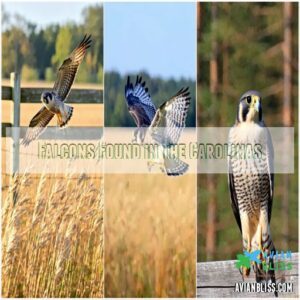
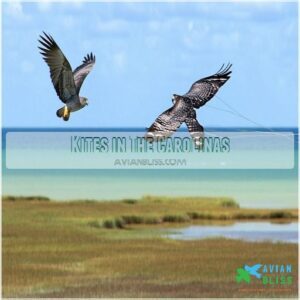
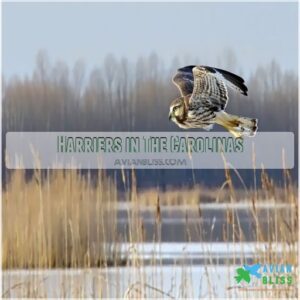


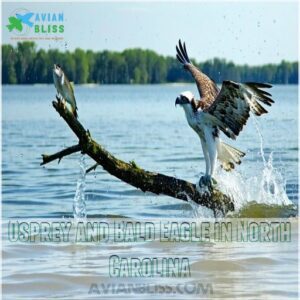
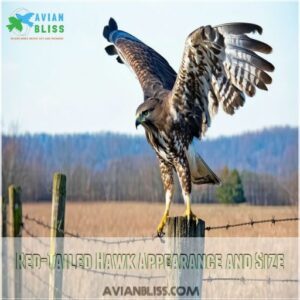
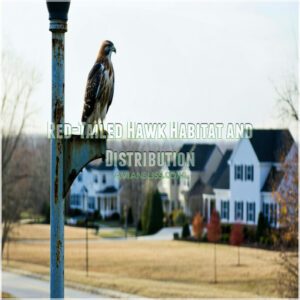
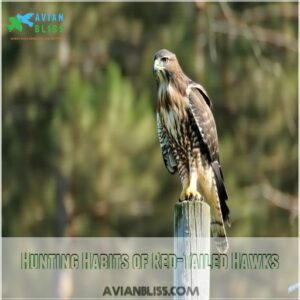
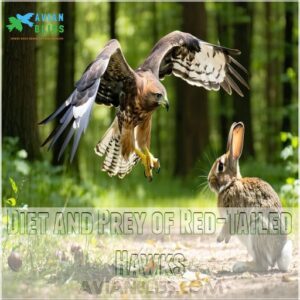
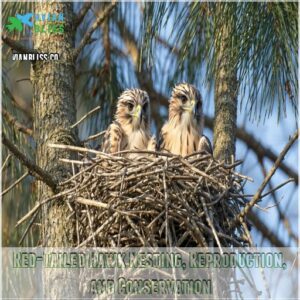
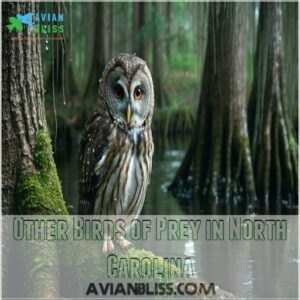
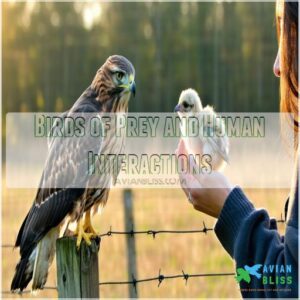




Bird Identification by Location: Guide to Spotting Nearby Birds
October 26, 2024 at 07:27 PM
[…] you’re not an ornithologist, spotting a Northern Cardinal in Eastern North America or a majestic Red-tailed Hawk soaring over open fields can be thrilling and […]